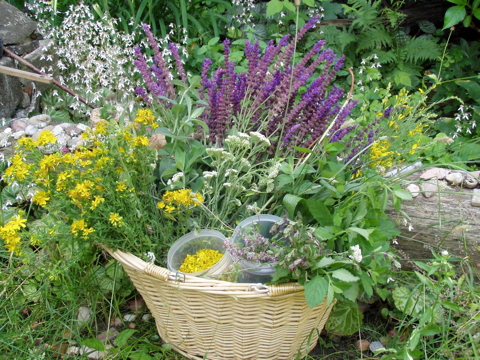The traditional use of wild medicinal and aromatic herbs on the territory of Bosnia and Herzegovina
The traditional use of healing herbs in different areas. Interviews with many famous healers in BiH about local herbal cures
The Ecological Aspect of Ethnobotany and Ethnopharmacology of Population in Bosnia and Herzegovina
.
 This paper contains first systematical revision of the results on traditional use of wild medicinal and aromatic herbs on the territory of Bosnia and Herzegovina (B&H) – west of Balkan Peninsula; Southeast of Europe.
This paper contains first systematical revision of the results on traditional use of wild medicinal and aromatic herbs on the territory of Bosnia and Herzegovina (B&H) – west of Balkan Peninsula; Southeast of Europe.
There have been detected 227 plants belonging to 71 different plant families, which are being used with ethno therapeutic purpose. Results were obtained by method of open ethno botanical interview which comprised 150 persons, whose average age was 63. Medicinal plants in ethno therapy are being used either in fresh, raw or dried condition. Different herbal parts, depending on period of vegetation season, sometimes even in winter, are basis for preparation of infusions (59%), decoct (19%), tinctures (4%). Especially original are balms known as Bosnian »mehlems«, which are fresh cuted herbal parts mixed with lukewarm resin, raw cow butter or honey. In ethno therapy are mostly being used aerial plant organs.
Majority of herbs is being used for treatment of illnesses of respiratory (22%), gastrointestinal (19%) and urinary and genital system (9%), for treatment of skin conditions (11%), as well as for nervous system and heart diseases (16%).
The most original plants on the field of ethno pharmacology, comparing with ethno therapy practice of other regions, are as follows: Ballota nigra, Aesculus hippocastanum, Calluna vulgaris, Centaurea cyanus, Euphrasia rostkoviana, Geranium robertianum, Gentiana asclepiadea, Helichrysum italicum, Lycopodium clavatum, Marrubium vulgare, Nepeta cataria, Populus tremula, Ruta graveolens, Tamus communis, Teucrium montanum, T. chamaedrys, and endemic plants Gentiana lutea subsp. symphyandra, Teucrium arduini, Micromeria thymifolia, Satureja montana, S. subspicata, Rhamnus fallax and Viola elegantula.
There haven’t been noticed significant differences in the frequencies of medicinal plants use among different ethnical groups. But, it has been perceived that longer ethno therapeutic tradition possess inhabitants of sub- and Mediterranean areas, as well as inhabitants of the mountain areas of B&H, regardless their ethnicity.
.
Introduction
Modern man’s relationship toward his diet and medical treatment since centuries ago is the most important part of both human ecology and process of anthropogenesis Man – Homo sapiens recens has been using wild flora in his diet since centuries ago, in the medicinal treatments, too. On the basis of human relationship toward use of wild flora with both healing and supplementary diet purposes could be made conclusions on process of anthropogenesis and ethno genesis, especially in some regions of the Earth. Thus, on the territory of Bosnia and Herzegovina (B&H) man has been turned to the natural resources in his surroundings since Neolithic days, especially to the wild medicinal flora.
Despite the fact that we are living at the beginning of the 21st century medicinal aspect of vascular flora has been insufficiently investigated10. It has been estimated that only 1% of vascular flora has been investigated on its pharmacological and physiological activity. On the other hand, the number of various pathological conditions of human organism that couldn’t be covered by conventional pharmaceutical means has been increasing.
Ordinary people tend to avoid standard pharmaceuticals whenever it is possible and to replace them with an adequate phyto pharmaceuticals. For these reasons the interest for phytotherapy and research in this field has been increasing over the last decades. A wise man said »There is a plant for every disease; it just has to be discovered«.
Our environment is still rich in various plants containing potential medicals even for the most dangerous diseases. Those plants just have to be discovered. Starting point of this kind of investigations should be complex ethno botanical research. The results of these have by now revealed numerous secrets insufficiently known to the modern science. Finally, the most important are the active principles contained in certain plant.
A wise man also said »The most important thing is to kill the pain«. The chemical composition, microscopy features of questioning species or its pharmaceutical aren’t so important. This statement is true. Therefore, ethno botanical investigations have got importance. There are numerous sources from all over the world that confirm afore named facts. The connection between ethno botany and phytochemistry as well as ethno botany and ethnopharmacology becomes closer and closer every day. Integration of ethno botany and phytochemistry becomes a modern dream.
.
Sulejman S. Redžić
Center of Ecology and Natural Resources, Faculty of Science University of Sarajevo, Sarajevo, Bosnia and Herzegovina
Department of Pharmaceutical Botany, Faculty of Pharmacy University of Sarajevo, Sarajevo, Bosnia and Herzegovina
Fult study is here: The Ecological Aspect of Ethnobotany and Ethnopharmacology of Bosnia and Herzegovina
